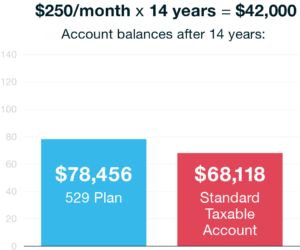Michigan 529 Basics
A 529 plan is a tax-advantaged savings/investment plan designed to encourage saving for the future expenses of a designated beneficiary (typically one’s child or grandchild). The plans are named after Section 529 of the Internal Revenue Code and are administered by state agencies and organizations.
Have a 529 Tax question and live in Michigan? Give ATS Advisors a call or send us an email!
Michigan 529 Plan Tax Deduction?
All 529 account investment earnings are exempt from state and federal taxes. Withdrawals made for qualified expenses — which now include both K-12 and college education costs — are not penalized by taxes.
Michigan law further provides a state tax deduction for contributions made to a Michigan Education Savings Program (529) account, up to $5,000 for individuals and $10,000 for joint filers. The Michigan 529 Plan Tax Deduction is available for the amount of contributions minus the amount of qualified withdrawals made within a given tax year.
Types of Section 529 College Savings Plans:
There are two types of 529 college savings plans: prepaid tuition plans and savings plans:
- Prepaid Tuition Plans allow for the pre-purchase of tuition based on today’s rates and then paid out at the future cost when the beneficiary is in college. Performance is often based upon tuition inflation. Prepaid plans may be administered by states or higher education institutions.
– The Michigan Education Trust (MET) is Michigan’s 529 prepaid tuition plan.
- Savings Plans are different in that your account earnings are based upon the market performance of the underlying investments, which typically consist of mutual funds. Savings plans may only be administered by states.
– The Michigan Education Savings Program (MESP) is Michigan’s direct sold 529 savings plan.
– The MI 529 Advisor Plan is Michigan’s advisor sold savings plan.
How do 529 accounts work?
529 accounts are education savings plans operated by a state or educational institution. They are named after Section 529 of the U.S. Internal Revenue Code that governs these types of savings plans. Contributions earn money from investments and are able to be used for an individual child’s educational expenses.
What kind of K-12 expenses can 529 dollars now be used for tax-free?
Changes made in 2017 to the federal tax code expand the definition of qualified expenses to include “tuition in connection with enrollment or attendance at an elementary or secondary public, private, or religious school.” This does not include tuition for pre-kindergarten schools or programs.
Legislation currently being considered by Congress would further expand the definition to include homeschool expenses, as well as several types of expenses that could benefit children enrolled in public or private schools: curriculum or online educational materials; tutoring services; AP, SAT, ACT or standardized achievement tests; dual enrollment higher-education programs; or therapies to help students with disabilities or other special learning needs.
Are separate 529 accounts needed for a child’s K-12 expenses and college expenses?
No. Federal law expanded the definition of qualified expense to include tuition for elementary and secondary education. This is in effect for 2018. A single 529 account for each child (considered the “designated beneficiary”) now may be used to pay for either elementary and secondary tuition, higher education expenses or both.
Who can set up a 529 account?
Any person can set up a 529 account and name an individual child as a beneficiary. Individuals do not need to have set up a 529 account in order to make contributions. Per IRS guidance, anyone can set up a 529 and name anyone as a beneficiary — a relative, a friend, even themselves. Check out the case studies below to see sample scenarios that show how a 529 plan may benefit a family like yours.
Michigan law also enables any of the following to open and contribute specifically to MESP accounts: “A state or local government agency or instrumentality, an entity exempt from taxation under section 501(c)(3) of the internal revenue code, an estate or trust, or a corporation that enters into a Michigan education savings program agreement.”
Are there any limits on 529 accounts?
There is no limit on 529 withdrawals to pay for higher education, but federal law limits withdrawals for elementary and secondary education expenses to $10,000 per year. Different 529 plans have maximum allowable account balances. For example, the MESP limits the amount to $500,000.
Also, according to the website 529 K12 Facts: “You can donate up to $15,000 per year ($30,000 if married filing jointly) beginning in tax year 2018 without incurring federal gift tax. Contributions of up to $75,000 ($150,000 if married filing jointly) also can be treated as having been made over a five-year period, for federal gift tax purposes.”
529 Example:

Parents start saving in a 529 plan at their child’s birth, contributing $250/month for 14 years (equaling $42,000). The tax-
deferred growth in the 529 plan’s earnings means $10,000 more of their own funds are available than if
they had invested in a standard taxable account. They decide to enroll their child in a private high school. Enough money is there to pay up to $10,000 for each year’s tuition, with remaining plan dollars free to help pay for higher education.